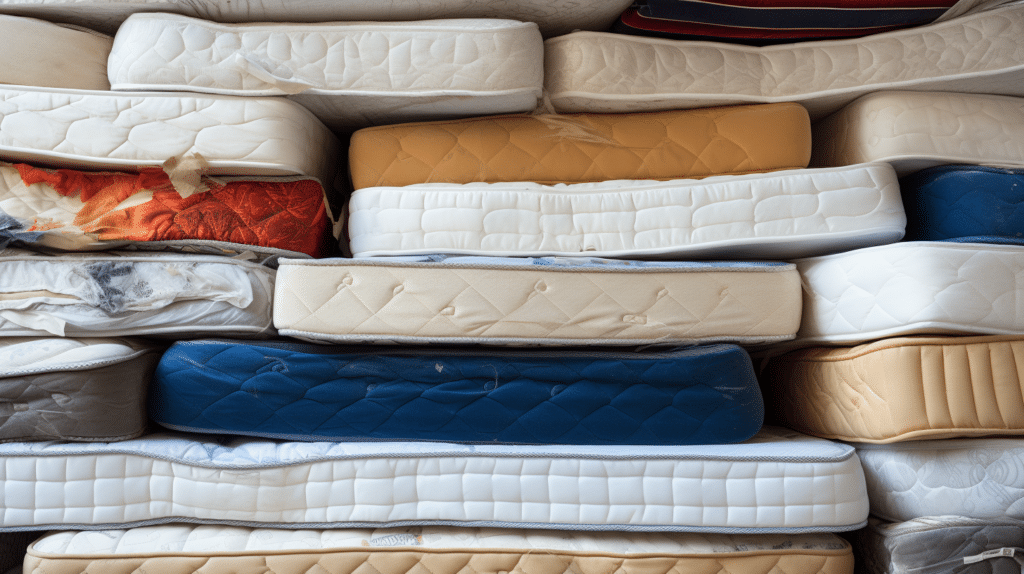Looking for ways to minimize mattress off-gassing and create a healthier sleeping environment? This article will provide you with essential safety tips to help you reduce the harmful chemicals emitted from your mattress. By understanding the causes of off-gassing, choosing low VOC emission mattresses, and incorporating natural materials, you can ensure better air quality in your bedroom. With practical advice on airing out your mattress, using protectors, and maintaining cleanliness, this guide will empower you to make informed choices for a safer sleep experience.
Understand the Causes of Mattress Off-Gassing
To minimize mattress off-gassing, you need to understand what causes it. The causes of off-gassing can be attributed to the chemicals used in the manufacturing process, such as adhesives, flame retardants, and polyurethane foam. These materials release volatile organic compounds (VOCs) over time, which can have negative health effects when inhaled. VOCs are known to cause respiratory issues, allergies, and even contribute to indoor air pollution.
One type of harmful chemical commonly found in mattresses is formaldehyde. This chemical is used as a bonding agent and can be released into the air as a gas. Exposure to formaldehyde has been linked to eye irritation, throat discomfort, and respiratory problems.
Another group of harmful chemicals often found in mattresses are flame retardants. These chemicals are added to meet fire safety standards but can also release toxic gases over time.
By understanding the causes of mattress off-gassing and being aware of the types of harmful chemicals involved, you can make informed decisions when purchasing a new mattress and take steps to minimize exposure for a healthier sleeping environment.
Choose a Mattress with Low VOC Emissions
When selecting a mattress, opt for one that has low VOC emissions. VOC stands for volatile organic compounds, which are chemicals that can be released into the air and potentially cause health issues. Low VOC mattresses have lower levels of these chemicals compared to high VOC mattresses. By choosing a mattress with low VOC emissions, you can reduce the off-gassing that occurs when you first bring it into your home. This is especially important if you or someone in your household is sensitive to strong odors or has respiratory issues. Low VOC mattresses provide several benefits in reducing off-gassing, such as minimizing exposure to harmful chemicals, improving indoor air quality, and promoting better overall health and well-being. So, make sure to prioritize a mattress with low VOC emissions for a healthier sleep environment.
Opt for Natural and Organic Mattress Materials
Choosing a mattress made from natural and organic materials can contribute to a healthier sleep environment. When it comes to natural vs. synthetic materials, there are pros and cons to consider. Natural materials, such as organic cotton or wool, are free from harmful chemicals and pesticides commonly found in synthetic options. They also tend to be more breathable, allowing for better airflow and temperature regulation throughout the night. On the other hand, synthetic materials may be more affordable but often contain volatile organic compounds (VOCs) that can off-gas and potentially impact indoor air quality. Understanding organic certifications is crucial when selecting an organic mattress. Look for certifications like Global Organic Textile Standard (GOTS) or Global Organic Latex Standard (GOLS), which ensure that strict standards have been met regarding the use of natural and organic materials throughout the manufacturing process.
Air Out Your Mattress Before Use
Before you use your mattress, make sure to air it out to ensure better indoor air quality. This step is crucial in minimizing off-gassing and preventing the release of harmful chemicals into your home environment. Here are a few tips to effectively air out your mattress:
- Remove all packaging: Take off any plastic covers or wrapping that may have been used during transportation or storage.
- Open windows and doors: Let fresh air circulate in the room by opening windows and doors for a few hours.
- Use fans or ventilation: Place fans near the mattress or use ventilation systems to increase airflow and speed up the process.
By allowing your mattress to breathe before using it, you can help reduce the intensity and duration of off-gassing. Remember, proper airing out is an important step in ensuring a healthier sleeping experience.
Use a Mattress Encasement or Protector
To ensure better indoor air quality, it’s recommended to use a mattress encasement or protector. Mattress encasements provide a barrier between you and the mattress, preventing off-gassing chemicals from being released into the air you breathe while you sleep. They also help protect your mattress from stains, spills, dust mites, and bed bugs.
When choosing a mattress protector, look for one that is made with breathable materials like cotton or bamboo. These materials allow for airflow while still providing a protective barrier. Additionally, consider a waterproof protector if you are prone to accidents or have young children who may spill liquids on the bed.
Some of the best mattress protectors on the market include SafeRest Premium Hypoallergenic Waterproof Mattress Protector and Linenspa Premium Smooth Fabric Mattress Protector. These options offer both protection and comfort without compromising on breathability.
Investing in a high-quality mattress encasement or protector not only helps minimize off-gassing but also prolongs the life of your mattress by keeping it clean and protected.
Keep Your Bedroom Well-Ventilated
Make sure you regularly open windows or use a fan to keep your bedroom well-ventilated, allowing fresh air to circulate and preventing the buildup of pollutants. Good ventilation is essential in minimizing mattress off-gassing. To further improve your bedroom’s air quality, consider using window treatments such as blinds or curtains that can be easily opened and closed. These treatments allow you to control the amount of natural light and fresh air entering your room. Additionally, indoor plants can help purify the air by absorbing toxins and releasing oxygen. Plants like aloe vera, spider plants, and snake plants are known for their ability to filter out harmful chemicals commonly found in indoor environments. By incorporating these simple strategies into your daily routine, you can create a healthier sleeping environment and reduce exposure to off-gassing from your mattress.
Avoid Direct Contact with Mattress Chemicals
Ensure you do not come into direct contact with the chemicals present in your mattress. Avoiding chemical exposure is essential to minimize health risks associated with off-gassing. Here are some tips to help you avoid direct contact:
- Use a mattress cover or protector: By adding a barrier between yourself and the mattress, you can reduce the chances of skin contact with potentially harmful chemicals.
- Wash bedding regularly: Regularly washing your sheets, pillowcases, and mattress covers can help remove any residue that may accumulate over time.
- Use mild detergents: Opt for mild detergents that are free from harsh chemicals to further minimize exposure.
- Dry thoroughly: Make sure to dry your bedding completely before using it again.
By following these precautions, you can minimize direct contact with mattress chemicals and reduce potential health risks associated with off-gassing.
Use an Air Purifier in Your Bedroom
Using an air purifier in your bedroom can help reduce the presence of harmful chemicals from your mattress. The benefits of using an air purifier include improving indoor air quality and minimizing off-gassing. When choosing the right air purifier for minimizing mattress off-gassing, there are a few factors to consider. Look for a purifier with a high-efficiency particulate air (HEPA) filter, as it can effectively capture and remove airborne particles, including volatile organic compounds (VOCs) emitted by mattresses. Additionally, consider the size of your bedroom and choose an air purifier that is suitable for that space. Some models also come with activated carbon filters, which can further enhance their ability to absorb VOCs. By using an air purifier specifically designed to reduce off-gassing, you can create a healthier sleeping environment and minimize exposure to potentially harmful chemicals from your mattress.
Regularly Clean and Maintain Your Mattress
Regularly cleaning and maintaining your mattress can help prolong its lifespan and ensure a fresh sleeping environment. To deep clean your mattress, start by vacuuming it to remove any dust or debris. Then, use a mixture of baking soda and water to spot clean any stains or odors. Let the mixture sit for about 30 minutes before vacuuming it up. Additionally, consider using a mattress topper for added protection and comfort. A mattress topper acts as a barrier between you and the mattress, preventing sweat, spills, and other contaminants from seeping in. It also provides extra cushioning and support for a better night’s sleep. By regularly cleaning your mattress and using a quality mattress topper, you can minimize off-gassing and enjoy a cleaner sleeping environment.
Stay Informed and Read Reviews
Staying informed and reading reviews can help you make an informed decision when purchasing a new mattress. It’s important to stay up to date with the latest information on mattress off-gassing and safety tips. By reading reviews from other consumers, you can get a sense of their experiences with different mattresses and how they have dealt with any potential off-gassing issues. Look for reviews that specifically mention off-gassing or chemical odors, as this will give you valuable insight into the product’s quality. Additionally, pay attention to any certifications or labels that indicate the mattress has low VOC emissions. Consumer feedback is crucial in understanding which mattresses are less likely to have strong odors and potentially harmful chemicals. So don’t forget to do your research and read those reviews before making a purchase.
Conclusion
In conclusion, by following these safety tips, you can effectively minimize mattress off-gassing in your home. Understand the causes and choose a mattress with low VOC emissions and natural materials. Air out your mattress before use and consider using a mattress encasement or protector for added protection. Avoid direct contact with any chemicals present in the mattress and use an air purifier to improve air quality in your bedroom. Regularly clean and maintain your mattress for optimal freshness. Stay informed by reading reviews to make informed decisions about your bedding choices.


